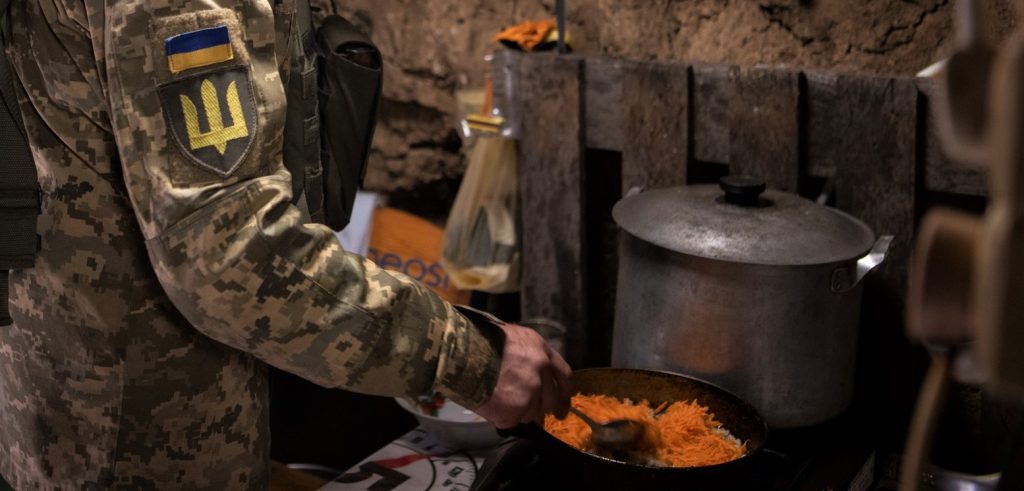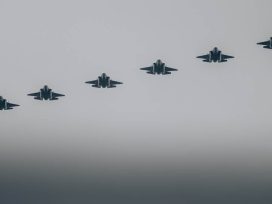Though the US has not entirely abandoned the idea of brokering a deal between Russia and Ukraine, it has become clear that the White House administration is no longer Ukraine’s ally but rather a negotiator between the two sides. Kyiv is now counting less on US military aid, looking to Europe for equipment and support. Ukrainians have never expected European or American boots on the ground. From the beginning of Russia’s full-scale invasion, Ukrainians knew that the only troops they could guarantee would be internal. Ukraine now has an 880,000-strong battle-hardened military – Europe’s largest and most experienced. According to Ukraine’s spy chief, Kyrylo Budanov, the country’s total defence forces exceed 1 million. In 2023 65% of Ukrainians attested to having loved ones at the front, a figure that is likely higher now.
However, while Ukrainians initially lined up voluntarily at military recruitment centres in 2022, mobilizing new recruits in the third year of a brutal war with virtually no rules – where Russia employs nearly all its available weapons, conducts relentless artillery fire, airstrikes and drone attacks, and openly tortures and executes prisoners – has become a major challenge. In a recent interview, president Volodymyr Zelenskyy stated that Ukraine has lost over 46,000 soldiers, with 380,000 wounded and tens of thousands missing in action. Acute personnel shortages are pushing the government to explore new mobilization strategies.
Last year The Public Interest Journalism Lab (PIJL), in collaboration with the Kharkiv Institute for Social Research (KISR), studied what motivates or deters people from military service. The following article draws on the study’s findings with added comment from new recruits and their families. Some interviewee names have been changed.
Family and unit
Sashko, a 45-year-old advertiser, didn’t join the Armed Forces of Ukraine (AFU) in 2022 because his wife was pregnant. He and Maryna, a 37-year-old journalist, who had been married for over a decade when they welcomed their daughter into the world in May 2022, put mobilization on hold. ‘My husband volunteered, helped military friends and built small drones. When our daughter started kindergarten, we knew we had to change our lives,’ says Maryna. ‘We reorganized family life: he serves, I raise our child, and he helps out when he can.’
Maryna believes this is the only viable model in Ukraine today: ‘Everyone should contribute to defence and not sit it out.’ Originally from Donbas, the couple lost their home and fled their hometown in 2014. They refuse to lose another in Kyiv. ‘Ten years ago,I visited the front as a journalist, hoping my young nephews wouldn’t notice what I was doing, says Maryna. Reflecting further on the early stages of war, she continues: ‘It didn’t work out. Now we must ensure things don’t freeze where they are. Otherwise, what was it all for?’ According to the UN, Ukraine lost over 13,000 lives and 20% of its territory was occupied from 2014 to 2021.
Sashko joined as a marine in May 2024 and is currently stationed on Ukraine’s northern border with Russia, utilizing his expertise in unmanned systems. Maryna says their biggest fear was that Sashko would end up in an unfamiliar unit, unable to contribute fully. ‘When my husband researched units, he asked about commanders and their treatment of subordinates. Friends’ direct feedback was decisive. It’s a combat unit where it’s imperative that everyone listens to one another.’ A unit HR officer guided Sashko through paperwork, training and onboarding, alleviating his primary fears of getting lost in the chaos of the war machine, finding himself in a completely unfamiliar place and losing control over his life.
Sashko’s brother-in-arms, Vitaliy, a 38-year-old banker from Dnipro, also delayed joining up in 2022 for family reasons: ‘My wife refused to move abroad with the kids. She stayed with me. I decided to help my family.’ In 2024, after receiving two draft summonses in the street, Vitaliy chose to serve. ‘I felt uneasy – others were serving, not me. I felt it was my time to go. I dropped my kids at school and texted a serving friend to help with a “reference letter”to his unit.’ Vitaliy signed a contract and joined the marines. Knowing he’d serve with friends and hearing honest feedback about the unit and commanders’ attitude toward subordinates was crucial.
Targeted recruitment and autonomy
The war has inflicted irreparable losses and increased existential insecurity. A key insight from the study suggests that fostering a sense of control in uncertain times, especially during recruitment, reduces anxiety and motivates war-traumatized people to enlist. Now that the war has entered its third year, respondents expressed a societal demand for autonomy. Both Sashko’s and Vitaliy’s families felt more in control knowing where their loved ones would serve, what they’d do and with whom. Multiple reputable units are always on the lookout for skilled drone engineers, so Sashko’s targeted posting with friends and receiving HR support were pivotal for his family. One civilian succinctly explained the popularity of certain Ukrainian military units: ‘Why do more people choose, for example, the Third Assault Brigade? Because they actually see what will happen to them there.’ Another respondent said: ‘Making your own decisions motivates – when you’re treated as a person, not cannon fodder.’
Soldiers and civilians alike noted how demotivating it is when specialized skills are ignored, sending people wherever manpower is needed, regardless of experience. Deployment to infantry assault units, which incur a high level of casualties, is especially concerning. As one young respondent admitted: ‘Here I am, an engineer with a degree. What position would they assign me to other than an assault soldier? And who would even care about this when there’s already a shortage of people? That’s what’s scary about it.’ One veteran urged: ‘Show people that their skills can get them a fitting role. Not everyone can be in assault troops.’ The army’s combat capability suffers from the inefficient distribution of people to units when their professional skills are not taken into account.
Military command nevertheless insists that, given Russia’s numerical advantage bolstered by North Korean units, they must send troops to hold trenches. In a war with scarce long-range, high-tech weapons, Ukraine is forced into symmetrical responses, sacrificing infantrymen.
Former Defense Minister Andriy Zagorodnyuk, now chairman of the Center for Defense Strategies, goes further, arguing that the solution lies not in numbers but in changing warfare tactics. On 1 June Ukraine conducted one such tactical development: Spider Web, a pioneering intelligence operation, targeted Russian strategic bombers, including those developed to carry nuclear bombs, with drones as far away as Murmansk above the Arctic Circle, over 8,000 km from Ukraine. In an unprecedented operation, which took 18 months to develop, more than 100 drones were smuggled into Russia, hidden and transported into five different regions close to the military bases and airports. They were then launched and piloted remotely. According to Ukrainian intelligence, Spider Web cost Russia 41 planes, calculating the damage at $7bln. The Russian Ministry of Defense has confirmed the attacks, but said that only a few planes were affected. Ukraine has targeted Russian military objects with drones numerous times over the past three years, but Spider Web is remarkable, due to its scale, range and ambition.
‘The army no longer expects many recruits from society’, says study co-author, sociologist, KISR director and soldier Denys Kobzin. ‘The Armed Forces of Ukraine has introduced tools like the Army+ app for transfers and handling cases of AWOL returns. Internal headhunting has surged over the past six months: units invest in ads for “more effective”, “new”, “top” units.’ Although not everyone, like Sashko, can choose their role, our study shows that Ukraine could expand its options for roles and units, letting recruits apply skills and take some control over their lives. After all, in the army, each army profession is important and all are needed. ‘When I hear, “I won’t touch a weapon”, it depresses me,’ says Vitaliy. ‘You can load ammo, cook food.’

59th Motorized Brigade household, 2022. Image via Ministry of Defense of Ukraine via Wikimedia Commons
Families play crucial role
Recruitment communication targets recruits, but families – wives, parents – often have the final say. For Sashko and Vitaliy, family circumstances delayed service, but spousal and parental support were key motivators to join the army. ‘My wife and mother were initially shocked,’ says Vitaliy. ‘But my wife said she saw I was unsettled at home. They’re proud of me and that’s motivating.’ Based on study evidence, we would recommend that messages are crafted for wives and mothers of men of draft age, explaining service benefits for families and the nation as a whole to help diminish traumatic registration experiences.
Admittedly, communication alone, without state or unit support, isn’t enough to drive change. ‘I have contacts for Sashko’s brothers-in-arms and commanders,’ says Maryna, ’but no one has reached out to me separately.’ She calls separate support for families ‘cool’. Patronage services such as contacting families during emergencies, offering aid and taking charge of injuries or deaths make a significant difference. Units like Azov provide effective support, building family communities – a model worth scaling.
When it comes to big decisions and conclusions, family is also a crucial source of information. Ukrainians have come to rely more heavily on informal sources of information such as Telegram and friends and family. An opinion poll from March 2024 conducted by the Ilko Kucheriv Democratic Initiative Foundation showed that the top three sources of information on the war are Ukrainian Telegram channels (53%), relatives, friends and colleagues (42%), and YouTube (40%).
Reluctance to serve doesn’t mean supporting Russia
Most respondents agree that the patriotic fervor of 2022 has waned. One military recruiter noted a government mistake at the time: ‘Many couldn’t enlist in the invasion’s early days, because their data hadn’t been recorded. No work was done with them and the patriotic zeal was lost.’
It is widely noted that, despite readiness to resist Russia, the sobering reality is that the most motivated individuals have already volunteered. One veteran pointed to an important change in people’s attitudes, which may partially explain the difficulties encountered during the mobilization process: at first, many people ‘rushed to defend’ the country as volunteers; later, civilians became convinced that ‘the guys are doing a good job’, a misconception reinforced by official communication. And then ‘fear set in’.
Respondents below draft age feel more financially and existentially insecure compared to other respondent groups. One of the young respondents said that ‘negative motivation’ had emerged because Ukrainians have begun looking at the war’s development more impartially: ‘The rose-colored glasses have gone, and the understanding and vision of the situation has become rational.’ Now that the war has become protracted, such sentiments indicate a more sober view. Ultimately, this will strengthen Ukraine’s resilience, as it will contribute to a more nuanced understanding of domestic and international circumstances. However, Russia will continue to actively exploit any sense of fatigue or pessimism to weaken Western support for Ukraine and destabilize Ukrainian society.
‘It’s clear that war isn’t for everyone. Not wanting to serve doesn’t mean wanting to become Russian,’ says Kobzin. ‘A consensus has formed: some fight, others live their lives. Many avoid the unpleasantries of the army, the loss of comfort, family, risking injury, or even death. Every war has been like this. This one is no exception.’
According to a 2024 survey conducted by the Ilko Kucheriv Democratic Initiatives Foundation in cooperation with the Razumkov Center sociological service, most Ukrainians (73%) believe that Russia must fulfill certain conditions before peace talks can begin. A poll conducted by the Kyiv International Institute of Sociology (KIIS) in September-October 2024 found that 81% of Ukrainians believe that Ukraine can succeed if the West provides adequate support. This survey was conducted before Donald Trump’s second election victory and his fluctuating support for Ukraine. However, most studies show that Ukrainians are not ready to accept peace on Russia’s terms and are ready to fight if there are no other alternatives to a just peace.
‘No one knows the exact losses; there’s a lot of criticism of commanders, weapon shortages. People often focus on the worst outcome of service – loss of life. Yet, people still enlist, even voluntarily,’ Kobzin says. ‘Talk of negotiations and expectations of a quick resolution will negatively affect these statistics. But we need to work not so much with those adamantly against service but with those who have fears that can be addressed.’
Vitaliy says Donald Trump’s statements motivated him to fight: ‘You know you need to be here.’ Maryna adds: ‘Every morning, I ask what negotiated outcome I’d want. I’d love my husband back soon but not at the cost of surrendering or forgiving the Russians. We can’t agree to freeze things as they are.’
In early February Ukraine’s Defense Ministry offered one-year contracts for 1 million hryvnias (€23,500) to attract 18-24-year-old recruits. Vitaliy says he called a friend who has a 20-year-old son when he heard about the initiative and asked if he was ready to go to war on such terms. The answer was no. ‘It’s a big sum, even with inflation, but I want motivated people beside me, not those joining out of desperation.’ Ukraine still lacks legally defined terms of service – a reform that soldiers and families had anticipated but was still absent from the 2024-updated mobilization law, so motivation, clear communication, and better training and service conditions remain critical encouragement.
What should Europeans prepare for?
US Vice President, J.D. Vance’s Munich Security Conference speech, claiming that Europe’s real security threat is its issues with internal democracy and free speech, not Russia, was a wake-up call for European leaders. With US troop presence in Europe and NATO ties in question, EU nations, especially Baltic and Scandinavian states, are revising their defence strategies.
In a potential NATO-Russia conflict, Western nations would have access to high-tech weapons, but training programmes would be lacking. As a RUSI report notes: ‘High-end weapons also require high-end troops. These take significant time to train – time which is unavailable in a war with high attrition rates.’
‘A key lesson: we weren’t ready in the first six months of the invasion to absorb many recruits. Our defence system – training, logistics – wasn’t prepared,’ says Kobzin. ‘You need to mobilize many people at the onset of aggression before they reconsider.’ Kobzin believes it is necessary to develop a system of training from childhood onwards. ‘Polls in European countries show that the percentage of people willing to fight with weapons today is small. Everyone thinks it won’t happen to their country. But we thought the same,’ he says. Europe should emulate Ukraine’s whole-of-society defence approach, fostering government, civil society, and business collaboration to build Western societal resilience and readiness to act.
‘Since the Second World War, Europe hasn’t questioned its survival. But large-scale war has returned to the continent and it is time to seriously rethink Europe’s security architecture, which has always relied on the US’s security umbrella,’ emphasizes Jaroslava Barbieri, doctoral student at the University of Birmingham and co-author of this study. ‘Today, Europe needs to have an honest and consistent conversation with its societies about the fact that war is already here, to reject the illusion that people are safe, and to finally abandon the old political strategies that tried to include Russia in the European security architecture. Talking about values, democracy and a common cultural space are empty words without a consistent conversation about the transformation of the European security framework.’ Barbieri considers exclusively focusing on a high-tech, professional army is flawed in light of the Ukrainian experience. During a full-scale invasion, virtually everyone has to be on the defensive. Society is ideally prepared. ‘The Ukrainian experience of how to communicate with society, how to encourage, how to take into account mistakes, is invaluable for Europe. Ukraine should be given a leadership role in conversations about changing the defence paradigm.’
The stories of Sashko and Vitaliy highlight findings from the 2024 PIJL and KISR study, based on 17 in-depth online interviews and discussions with three focus groups conducted in March and April across Ukraine. Participants included active AFU soldiers, civilian men (above and below draft age), wives and mothers of soldiers, and veterans. The Public Interest Journalism Lab is a Ukrainian media NGO, which promotes constructive discussion around complex social topics, combining content creation and sociological research, to explore how to overcome polarization.







